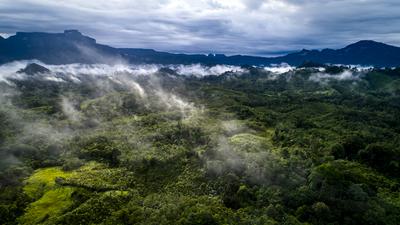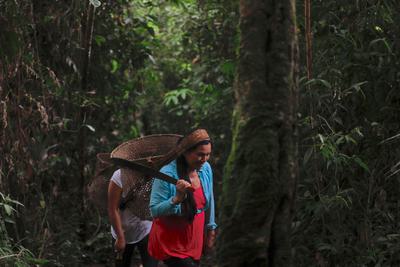Activists say the initiative would enable governments and corporations to take carbon rights from Indigenous communities.
And some land-rights activists say LEAF threatens to create a global “carbon grab,” in which governments and corporations take carbon rights in forests from Indigenous people and local communities, thus excluding them from selling carbon credits to fund their own conservation work.
“The nub of the issue is that LEAF further incentivizes governments to assert state ownership over carbon rights [and] capture the benefits of the trade,” says Andy White, a senior advisor at the Rights and Resources Initiative (RRI), an international coalition of land-rights holders and their allies.
The scale for potential carbon grabs is huge. A review by RRI and McGill University, published in May, found that most of the lands and territories targeted for offsets “overlap with areas customarily held by Indigenous Peoples, local communities, and Afro-descendant Peoples.” It estimated that these forests held around 300 billion tons of carbon. Yet forest communities had legal title to only 10 percent of their forests, and carbon rights to even less.
In Peru, the Kichwa people know all about carbon grabbing. They say their long-standing conflicts with the Peruvian government over forests rights shows the risks others may soon be facing.
For more than a decade, the Peruvian government has been selling carbon credits from conserving forests in the Cordillera Azul National Park, which the Kichwa claim as their own ancestral land. The sales have been made to corporate purchasers, including Ben & Jerry’s, Shell, and British Airways, without discussion with — or compensation for — the Kichwa.
In July, the country’s environment minister Gabriel Quijandría announced “the largest sale of carbon in Peru’s history,” when it sold an additional $87 million of carbon credits from the park to an unnamed “international extractive sector company.”
Magdalena Santi, a Native Kichwa, leads her daughter through the forest in Sarayaku, Ecuador. Franklin Jacome / Getty Images
The Kichwa have recently gone to court to challenge their government’s refusal to recognize their forests and carbon rights in the park. “It is Indigenous peoples who care for, protect, and ensure the survival of the forests, including by reforesting to mitigate climate change,” Marisol García Apagüeño, secretary of the local Kichwa federation, FEPIKECHA, told Yale Environment 360. “Yet the government denies that we are traditional owners, and do not even consult us.”
The Glasgow Conference of Parties to the UN climate change convention, known as COP26, will be the biggest such event since the successful Paris Agreement of 2015, which pledged nations to set “net zero” emissions targets for greenhouse gases by mid-century. Most nations in Glasgow will announce plans for toughening their carbon pledges, known as Nationally Determined Contributions, using conservation projects to keep more carbon in their forests — so-called carbon offsets.
But developing nations need finance to make this happen. Many are looking for big bucks from big corporations. So the Glasgow meeting is expected to give the green light to allow them to tap into privately financed “voluntary” offset projects that have, until now, only been used by corporations to reduce their carbon footprints and green their public profiles. Governments will in the future be able to claim the carbon captured by such schemes within their own territories to reduce the emissions they declare to the UN. LEAF intends to become a key intermediary in delivering the finance and setting the rules for these nation-scale carbon offsets. It is run by Emergent, a nonprofit formed by the Environmental Defense Fund and others and announced on Earth Day in April at a climate summit hosted by U.S. President Joe Biden. It has the support of governments in the UK, the United States, and Norway, as well as from private-sector giants such as Amazon, Bayer, GlaxoSmithKline, Nestle, Airbnb, McKinsey, Delta Airlines, and Unilever.
The hope is that LEAF will unlock the potential of the largely discredited UN REDD+ carbon offset program.
“Finally, tropical forest countries can be assured that financial rewards are available if they can demonstrate reduced deforestation,” said Norway’s then-prime minister Erna Solberg at the launch.
LEAF claims so far to have received 30 proposals for carbon-capturing forest projects covering half a billion hectares, an area more than half the size of the U.S., and to have completed technical assessments for future projects in Brazil, Burkina Faso, Costa Rica, Ecuador, Guyana, Kenya, Mexico, Papua New Guinea, Nepal, Nigeria, Uganda, Vietnam, and Zambia. It is expected to announce major new funding at the COP next week.
The hope is that it will unlock the potential of the moribund and largely discredited UN system for Reducing Emissions from Deforestation and Forest Degradation (REDD+), by raising standards and increasing confidence for investors, as well as governments and forest communities.
LEAF-sanctioned offsetting will operate under new rules drawn up by an independent group of forest experts chaired by Frances Seymour of the World Resources Institute, a U.S. think tank. The rules are known by another acronym, TREES, which stands for The REDD+ Environmental Excellence Standard.
Seymour said the rules will be good for Indigenous peoples and local communities as well as for climate. They “represent an opportunity to advance the rights of Indigenous peoples and other local communities,” by requiring governments to work with them. Offsets must “ensure the recognition, respect, protection, and fulfillment of the rights of Indigenous peoples and local communities,” she said.
This could become a battle between those who support big offset projects and those who want to protect Indigenous rights.
But some land rights activists fear it could be a poisoned chalice. Tom Younger at the UK-based Forest Peoples Programme, a human rights advocacy group, says that while the safeguards are “good on paper,” they are likely to be undermined by national laws of forests that discriminate against Indigenous people. Alain Frechette at RRI says that the rules do not meet standards set by the UN Declaration on the Rights of Indigenous Peoples.
A crucial issue is the proposed size of the accounting areas for carbon. The TREES rules state that, to qualify for carbon credits, governments and corporations will need to show an overall carbon gain in the whole country’s forests or a minimum of 2.5 million hectares — an area roughly the size of New Hampshire.
This large scale has two potential benefits, say LEAF advocates. It scales up ambition, and it may reduce “leakage,” which occurs where deforestation is not reduced but simply displaced to somewhere outside the offset area. But Andrea Johnson, a consultant at the Climate and Land Use Alliance, says that this scale leaves governments “de facto owners of forest carbon.” Younger says it “makes LEAF mostly accessible only to states that can claim large areas of forests as state lands.” Indigenous communities could rarely establish their own projects and would become, at best, bit-part players in a game ruled by their governments.
“There is no way LEAF could get away with this top-down centralization of carbon rights in the U.S.,” says White of RRI. “Private property owners, communities, and local jurisdictions would never support it.”
On the face of it, this debate could become a battle between those who want to fix the climate with big offset projects and those who want to protect Indigenous rights. But many environmentalists increasingly see forest communities as the best custodians of forests — better often even than formally protected national parks, according to recent reports by the World Resources Institute and the UN Food and Agriculture Organization. In the Peruvian Amazon, the titling of Indigenous lands reduced forest clearing by three-quarters within two years.
Indigenous lands on the western end of the Brazilian Amazon have seen far less deforestation than surrounding areas. World Resources Institute
The International Union for Conservation of Nature, at its Congress in September in Marseilles, France, recognized this when it called for “full and effective participation of indigenous peoples” in conservation. Without them, forest conservation is unlikely to succeed, however many dollars are put into it.
Johnson, who admits to “complex feelings” about the pros and cons of LEAF, says she hopes that the involvement of prestigious corporations such as Amazon may stop the abuse of the rights of forest communities in the name of fighting climate change. Investors, she says, should “make clear they want credits associated with social justice, not social conflict. I am rooting for LEAF. It has the potential to be a game-changer.”
But despite its big backers and billion-dollar ambitions, LEAF is not the only game in town. In Glasgow next week, Indigenous representatives will say they have an important role in delivering nature-based solutions to climate change through protecting and restoring their forests. But the starting point, they say, must be establishing their rights to forests and the carbon they contain. So, supported by RRI and other land-rights advocates, they plan to launch alternative funding mechanisms that give priority to fulfilling the carbon rights and conservation plans of forest dwellers rather than governments and corporate clients. This initiative could gain traction. The lead promoter is the Global Alliance of Territorial Communities (GATC), whose Indigenous and other members control more than 840 million hectares of forests across the tropics, an area larger than the contiguous U.S.
GATC coordinator Tuntiak Katan, of the Ecuadorian Shuar people, who will be in Glasgow, notes: “we are ready to contribute our forests to one of the most important challenges of our era: the restoration of the Earth … However, real restoration can only happen with legal recognition of our rights to our territories. Without this, it will not be possible to ensure … climate security.”
Yale Environment 360 receives grant funding from the Climate and Land Use Alliance, which is cited in this article.





